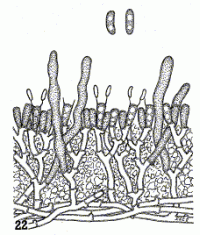|
 Corticium otagense Corticium otagense
BiostatusPresent in region - Indigenous
Images (click to enlarge)
Caption: FIG. 22. Corticium otagense. Showing the projecting submoniliform gloeocystidia,
masses of crystals embedded among the context hyphae, and basidia with two
allantold spores. |
Article: Stalpers, J.A. (1985). Type studies of the species of Corticium described by G.H. Cunningham. New Zealand Journal of Botany 23(2): 301-310 (http://www.rsnz.org/publish/abstracts.php).
Description: Hyphae hyaline, thin-walled, 3-5 µm wide, with clamps. Cystidia clavate to cylindrical, often
constricted, sometimes with 1-3 apical constrictions, 32-55 X 5-8 µm, but some swellings up
to 14 µm wide. Mature basidia not seen. Spores hyaline, thin-walled, smooth, cylindrical to
allantoid, 8.5-10.5 2.5-3.2 x 3-4 µm, sometimes slightly constricted, not amyloid.
Notes: The original description points to Galziniella pereximia Parm., but the absence of mature
basidia allows neither a positive identification nor an unequivocal assignment to a genus.
However, the species may, like Galziniella pereximia, belong to Sistotrema Fr.
Article: Cunningham, G.H. (1963). The Thelephoraceae of Australia and New Zealand. New Zealand Department of Scientific and Industrial Research, Bulletin 145: 359 p. Wellington:.
Description: Hymenophore annual, membranous, adherent, effused forming irregularly linear
areas to 18 x 4 cm; hymenial surface granulose-porose, white or pallid cream, not
creviced; margin thinning out, white; fibrillose, adherent. Context white, 80-120 µ
thick, basal layer of a few repent hyphae, intermediate layer of mainly erect hyphae
more freely branched in the subhymenium; generative hyphae 4-4.5 µ diameter,
walls 0.25 µ thick, most encrusted, with clamp connections. Gloeocystidia arising in
the context, projecting to 20 µ, moniliform or tortuous, 40-58 x 5-8 µ, scanty.
Hymenial layer to 30 µ deep, an interrupted palisade of basidia, paraphyses, and
gloeocystidia arranged in tufts. Basidia subclavate, 16-20 x 4.5-5 µ, bearing 2
spores; sterigmata arcuate, slender, to 5 µ long. Paraphyses subclavate, 12-16 x 4-4.5 µ;
both basidia and paraphyses encrusted. Spores rod-shaped, or allantoid,
apices rounded, bases apiculate, 8-9 x 2.5-3.5 µ, walls smooth, hyaline, 0.1 µ thick
Habitat: HABITAT: Effused on bark of dead branches.
Distribution: TYPE LOCALITY: Stewart Island, Otago, New Zealand.
DISTRIBUTION: New Zealand.
Notes: Identified by the thin hymenophore, somewhat corymbose basidia arranged in tufts
so that the hymenial surface appears slightly granulose-porose, basidia with two
rod-shaped or allantoid spores, and moniliform gloeocystidia. Basidia, paraphyses,
and most context hyphae are encrusted with fine crystals. Although most spores are
rod-shaped, a few are allantoid. Gloeocystidia are moniliform or tortuous with
deeply staining contents. The species differs from C. bisporum (Schroet.) Hoehn. &
Litsch. in the presence of gloeocystidia, large rod-shaped spores and abundant
clamp connections.
|